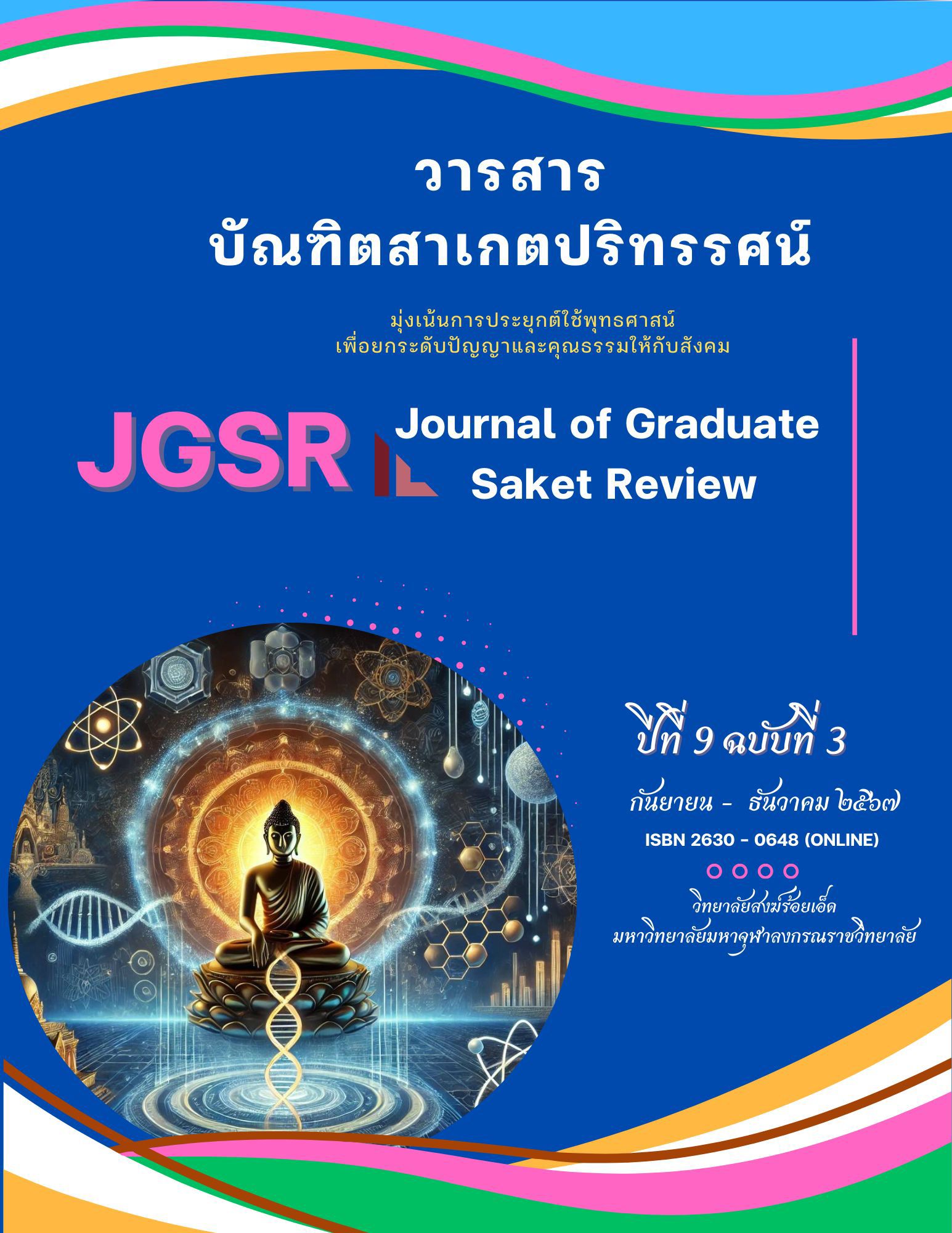การจัดการเชิงกลยุทธ์ที่ยั่งยืนของภาพวาดของเกษตรกรตงเฟิง ในจังหวัดจี๋หลิน สาธารณรัฐประชาชนจีน
Main Article Content
บทคัดย่อ
การบทความวิจัยนี้มีวัตถุประสงค์เพื่อ วิเคราะห์และกำหนดแนวคิดและกรอบการทำงานสำหรับการพัฒนาที่ยั่งยืนของภาพวาดของเกษตรกรตงเฟิง ใช้ทฤษฎีสมัยใหม่เพื่อสร้างแบบจำลองทางทฤษฎีและรูปแบบเชิงกลยุทธ์ที่ใช้กับการพัฒนาที่ยั่งยืนของภาพวาดของเกษตรกรตงเฟิง กำหนดนโยบายการดำเนินงานและตัวชี้วัดการประเมินผล การวิจัยแบบผสมผสาน โดยใช้การทบทวนวรรณกรรม การสำรวจภาคสนาม ใช้เครื่องมือแบบสอบถามและการสัมภาษณ์เชิงลึก โดยมุ่งเน้นไปที่พื้นที่การผลิตภาพวาดของเกษตรกรตงเฟิง ในกระบวนการวิจัย ได้นำวิธีการสุ่มตัวอย่างแบบคลัสเตอร์มาใช้ ผลการศึกษาระบุว่า : 1) ผลการศึกษาข้อแรกเรื่องประวัติศาสตร์และพัฒนาการของการสร้างผลงานภาพวาดเกษตรกร เมืองตงเฟิง เป็นพื้นที่แหล่งเกษตรกรรม มีระบบการเพาะปลูกที่ดี มีทิวทัศน์ที่สวยงาม มีอาคารเก่าสมัยราชวงศ์ชิง แสดงถึงการเกิดเมืองที่มีความเจริญตั้งแต่สมัยราชวงศ์ชิงเป็นต้นมา มีวัฒนธรรมที่โดดเด่นกว่าร้อยปีและที่ผ่านมาได้เกิดวัฒนธรรมผลงานวาดภาพของชาวนาขึ้น ซึ่งภาพเขียนมีแนวคิดจากประเพณีวัฒนธรรม วิถีชีวิตในชุมชน ทำให้มีสไตล์ที่เป็นอัตลักษณ์ของท้องถิ่น ต่อมาได้รับการจัดเป็นมรดกทางวัฒนธรรมขึ้น 2) ผลการศึกษาข้อสองวิเคราะห์องค์ประกอบต่าง ๆ จากการวิเคราะห์ทาง PEST และ SWOT พบว่าเกษตรกรจะต้องนำเสนอเรื่องราวเกี่ยวกับธรรมชาติในพื้นที่ของตน ประเพณีวัฒนธรรม ความเชื่อ วิถีชีวิต เพื่ออนุรักษ์อัตลักษณ์ของตนไว้ นอกจากนั้น นักวิชาการทางศิลปะจะต้องสืบทอดองค์ความรู้ภาพเขียนไว้ และรัฐจะต้องส่งเสริมนโยบายตลอดไปในมิติด้านต่าง ๆ 3) ผลการศึกษาข้อสาม ได้รูปแบบการจัดการเชิงกลยุทธ์ที่ยั่งยืนของภาพวาดของเกษตรกรตง ซึ่งรัฐที่มีหน้าที่โดยตรง ปลูกถ่ายทางการศึกษา สอนความรู้และกระบวนการผลิตให้กับชาวนาและเยาวชนในพื้นที่ มีความเข้าใจอย่างลึกซึ้งเกี่ยวกับประวัติศาสตร์พื้นที่ สอนความรู้ องค์ประกอบทางศิลปะ ทฤษฎีทางศิลปะ สุนทรียศาสตร์ รูปแบบกลยุทธ์นี้จะเป็นการเพิ่มประสิทธิภาพอย่างต่อเนื่องและยังเป็นการปกป้องวัฒนธรรมให้ยั่งยืนอีกด้วย
Article Details

อนุญาตภายใต้เงื่อนไข Creative Commons Attribution-NonCommercial-NoDerivatives 4.0 International License.
เนื้อหาและข้อมูลในบทความที่ลงตีพิมพ์ในวารสารบัณฑิตสาเกตปริทรรศน์ ถือเป็นข้อคิดเห็นและความรับผิดชอบของผู้เขียนบทความโดยตรงซึ่งกองบรรณาธิการวารสาร ไม่จำเป็นต้องเห็นด้วย หรือร่วมรับผิดชอบใด ๆบทความ ข้อมูล เนื้อหา รูปภาพ ฯลฯ ที่ได้รับการตีพิมพ์ในวารสารบัณฑิตสาเกตปริทรรศน์ ถือเป็นลิขสิทธิ์ของวารสารบัณฑิตสาเกตปริทรรศน์ หากบุคคลหรือหน่วยงานใดต้องการนำทั้งหมดหรือส่วนหนึ่งส่วนใดไปเผยแพร่ต่อหรือเพื่อกระทำการใด ๆ จะต้องได้รับอนุญาตเป็นลายลักอักษรจากวารสารบัณฑิตสาเกตปริทรรศน์ ก่อนเท่านั้น
เอกสารอ้างอิง
Chen Chunhua, Zhu Li, (2017). Strategic Thinking and Organizational Capability in the Digital Age. Chinese and Foreign Management. (12), 88-90.
Cui Haiwei, (2013). Formation and Preliminary Implementation Study of China's Sustainable Development Strategy (1992-2002) [D]. Central Party School of the Communist Party of China, Retrieved April 20, 2023, from Http://www.chinamhl.com/96/ 152.html
Laurajane Smith, authored by, translated by Su Xiaoyan and Zhang Chaozhi. (2020). Heritage as a and Cultural Process. In Laurajane Smith (Ed.). translated by Su Xiaoyan and Zhang Chaozhi, Uses of Heritage Science Press.
Michael E. Porter, authored by, translated by Chen Lifang (2014). Strategic Decision-Making, in Michael E. Porter, authored by, translated by Chen Lifang Strategy. CITIC Press.
Song Junhwa, (2023). The Concept of Sustainable Development and Systematic Protection of Intangible Cultural Heritage" [J]. Cultural Heritage. (03), 1-8.
Zhang Ling, (2021). Intangible Cultural Heritage and Sustainable Development" [J]. Forum on Folk Culture. (01), 13-19.


